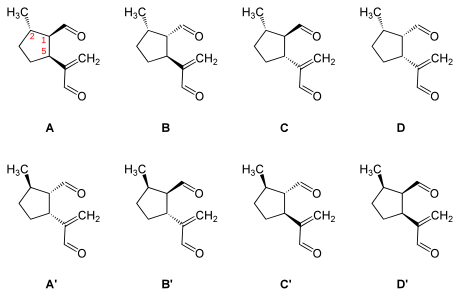Dolichodial
| Structural formula | ||||||||||
|---|---|---|---|---|---|---|---|---|---|---|

|
||||||||||
| Structural formula without stereochemistry | ||||||||||
| General | ||||||||||
| Surname | Dolichodial | |||||||||
| other names |
|
|||||||||
| Molecular formula | C 10 H 14 O 2 | |||||||||
| External identifiers / databases | ||||||||||
|
||||||||||
| properties | ||||||||||
| Molar mass | 166.22 g mol −1 | |||||||||
| Physical state |
liquid |
|||||||||
| safety instructions | ||||||||||
|
||||||||||
| As far as possible and customary, SI units are used. Unless otherwise noted, the data given apply to standard conditions . | ||||||||||
Dolichodial is a monocyclic mono terpene with two aldehyde groups , which belongs to the group of iridoids .
Dolichodial and its stereoisomers are found in the essential oil of certain plants, but also in the defensive secretions of some insect species .
Isomers
Dolichodial has three asymmetric carbon atoms in its five-membered ring and therefore occurs in four diastereomeric pairs of enantiomers . The pairs with a stereochemistry other than dolichodial are called anisomorphalic and peruphasmal.

All eight stereoisomers are shown
- (1 R , 2 S , 5 S ) = (-) - Dolichodial ( A )
- (1 S , 2 S , 5 S ) = (+) - Anisomorphal ( B )
- (1 S , 2 S , 5 R ) = Peruphasmal ( C )
- (1 S , 2 S , 5 R ) = D
- (1 S , 2 R , 5 R ) = (+) - Dolichodial ( A ′ )
- (1 R , 2 R , 5 R ) = (-) - Anisomorphal ( B ′ )
- (1 S , 2 R , 5 S ) = Peruphasmal ( C ′ )
- (1 R , 2 R , 5 S ) = D ′
In nature, that of Dolichodial C-2 epimeric (+) - Anisomorphal ( B ), which was also referred to as trans - (+) - Dolichodial, often occurs . A ' to D' are the mirror images of A to D ( enantiomers ). The compounds D and D ′ have not yet been found in nature.
Occurrence and use
Dolichodial (A) was first isolated from glandular ants of the genera Dolichoderus and Iridomyrmex in 1960 . It was not until sixteen years later that it was found in a plant, the cat germander Teucrium marum , as an essential component of the essential oil. The anisomorphal (B) was described in 1962 as the main component of the defense secretion of the ghost insect Anisomorpha buprestoides . It is also found in smaller quantities in the cat's gauntlet. The Peruphasmal (C) takes its name from the ghost insect Peruphasma schultei , which uses this stereoisomer as the main component in its defense secretion. Recent studies show that A. buprestoides uses not only anisomorphalic but also peruphasmal and dolichodial in the defense secretion. Depending on the geographic origin, the age of the animal and individual circumstances, one of the three connections can dominate. Sexually mature animals produce peruphasmal almost exclusively. Only dolichodial is found in the defense secretion of the larvae of some species of sawfly of the genus Craesus . The fringed winged callococcithrips fuscipennis uses a mixture as defense secretion which, in addition to alkanes and esters, also contains dolichodial and another substance that may correspond to the stereoisomer D or D 'of dolichodial.
Individual evidence
- ↑ This substance has either not yet been classified with regard to its hazardousness or a reliable and citable source has not yet been found.
- ↑ External identifiers of or database links to (-) - Dolichodial A : CAS number: 60478-52-6, PubChem : 442422 , ChemSpider : 390862 , Wikidata : Q90010331 .
- ^ GWK Cavill: Insect terpenoids and nepetalactone. In: WI Taylor, AR Battersby (Ed.): Cyclopentanoid terpene derivatives. Dekker, New York 1969, pp. 203-238.
- ^ AT Dossey, S. Walse, AS Edison: Developmental and geographical variation in the chemical defense of the walkingstick insect Anisomorpha buprestoides. In: Journal of Chemical Ecology. 34, 2008, pp. 584-590, doi: 10.1007 / s10886-008-9457-8 .
- ↑ JL Boevé, JC Braekman, D. Daloze, M. Houart, JM Pasteels: Defensive secretions of Nematinae larvae (Symphyta - Tenthredinidae). In: Cellular and Molecular Life Sciences (CMLS). 40, 1984, pp. 546-547, doi: 10.1007 / BF01982322 .
- ↑ G. Tschuch, P. Lindemann, G. Moritz: An unexpected mixture of substances in the defensive secretion of the Tubuliferan thrips, Callococcus fuscipennis. In: Journal of Chemical Ecology. 34, 2008, pp. 742-747, doi: 10.1007 / s10886-008-9494-3 .